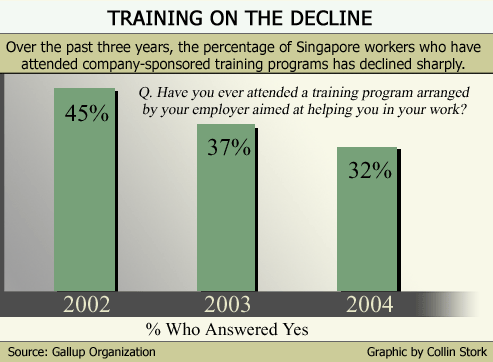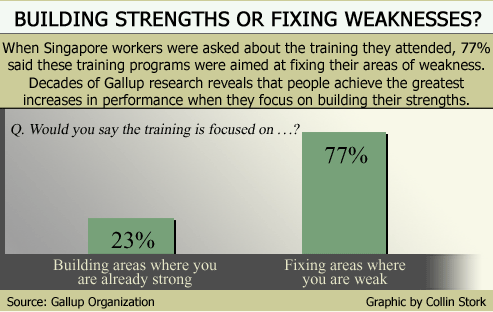The media in Singapore regularly carry reports about employee learning or "retooling" efforts that have been launched by the government. Those programs aim to make citizens more employable and successful in today's highly competitive marketplace. Businesses, too, spend large amounts of time and money drawing up extensive training schedules for their employees.
However, fundamental questions arise regarding these investments: Does training really address core objectives, such as promoting world-class performance among employees while heightening their engagement levels? And if these goals are not being met, what are the obstacles to success?
To answer these questions, The Gallup Organization asked employees in Singapore about their experiences with employee training programs as part of its annual Singapore Workforce Engagement Index survey. The results suggest that there are key issues that companies should consider when thinking about their training programs. These issues have significant implications for how Singapore's companies -- and organizations everywhere -- can maximize the returns from training.
Attendance at training programs is on the decline
A review of responses from the past three years reveals this trend: Although training may get significant coverage in the media, the percentage of respondents who have attended company-sponsored training has actually declined sharply.
 |
Given that Singapore is emerging from a recent economic downturn, it's possible that training budgets might be getting trimmed due to short-term economic considerations. But it's also possible that training efforts have not yielded the expected boost in employee performance, resulting in budget cutbacks.
Training aims to fix weaknesses
Survey respondents who had been through training in the past six months were asked whether that training focused on building their strengths or fixing areas of weakness. In three of every four cases, respondents were attending training programs to fix their areas of weakness. Yet decades of Gallup research reveals that people achieve the greatest increases in performance when they focus on building their strengths.
 |
Although building strengths can lead to world-class performance, training to improve areas of weakness is essentially damage control -- by aiming to eliminate defects, it inspires adequate, not superior, performance. (See "How Marriott Vacation Club International Engages Talent" and "An Eye for Talent" in See Also.)
This doesn't mean training is worthless. Even in this sample, 93% of the respondents who had been through training reported that it had helped them do their jobs better. But the key question remains: What will generate the strongest results for a company -- a remedial approach based on weakness prevention that produces marginal improvements or a strengths development approach that could boost employee performance to levels of excellence?
Replies to another survey question reveal a related problem: Only about one in five of Singapore's employees are in roles that allow them to use their talents on a daily basis. The fact is, training can do wonders for the right person in the right job -- especially when that training builds on the employee's greatest talents. But all the training in the world cannot make an employee the right person for the job.
These findings have serious implications for Singapore businesses, especially those in which customer service is key. The latest Global Competitiveness Report reveals that Singapore has slipped to 21st place in providing excellent customer service, down from an impressive 8th-place ranking just six years ago. As a result, there is much talk about launching training programs to help employees become more "customer-centric." But training can go only so far. To drive real change, companies must develop strategies to hire more customer-focused employees in the first place, then provide them with strengths development opportunities that can help them become world-class.
Training is only one factor in building employee engagement
The survey results suggest that the engagement levels of employees who have been through training are slightly higher than engagement levels of those who have not. Those who indicate they have been through training are 43% more likely than those who have not been through training to say they have had opportunities at work to learn and grow.
But these numbers don't tell the whole story -- learning and growing can be counterproductive in isolation. Gallup's research has revealed that there are 12 key dimensions that companies must manage to enhance employee engagement, and providing opportunities to learn and grow is just one of them. (See "Feedback for Real" and "Item 12: Opportunities to Learn and Grow" in See Also.)
For example, if employees are learning and growing but don't know what is expected of them at work, they can become frustrated in their roles and may start exploring job opportunities at other companies. This does not mean that providing opportunities for employees to learn and grow is wrong. What would be wrong is to believe that just providing these opportunities will guarantee that employees will become more engaged and successful.
Managing all of the dimensions
Organizations that want to increase employee engagement need a performance management system that is geared toward developing it. Giving people more opportunities to learn can play a part, but companies must manage all the dimensions that drive engagement, not focus on just one.
The world's best companies recognize that employees flourish when they are placed in roles that play to their talents. Thus, organizations should not try to "bestow talents" on their employees; instead, they should work to maximize the greatest talents within those individuals. To become world-class, companies must first focus on selecting the right employees into each role -- then on helping them develop into excellent performers in those roles.
The best companies also know that employee engagement begins at the workgroup level with great front-line managers. As noted in Gallup's management book First, Break All the Rules, "An employee may join a company because of its prestige and reputation, but . . . his relationship with his immediate manager determines how long he stays and how productive he is while he is there." And the world's best managers actually maximize the impact of training by developing employees' strengths rather than trying to improve upon their weaknesses.
Results of this survey are based on nationally representative samples of about 1,000 employed adults aged 18 and older. Interviews were conducted by telephone May 2001-October 2004. For results based on samples of this size, one can say with 95% confidence that the error attributable to sampling and other random effects could be plus or minus three percentage points. For findings based on subgroups, the sampling error would be greater.